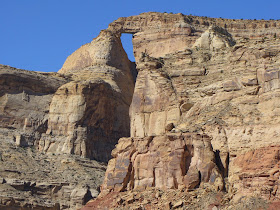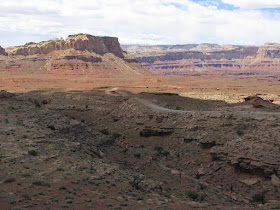Monday, January 9, 2012
A Lucky Strike In the San Rafael
Monocline. Anticline. These are the terms geologists apply to landforms when a section of the earth's crust warps or buckles upwards, forming an elongated ridge. Lacking modern scientific insight early anglo pioneers called them reefs, folds, and swells, and viewed them as obstacles to travel in whatever region they found them. There are several of these structures found in the heart of the Colorado Plateau, including one of my favorites, the San Rafael Swell.
The Swell began as an anticline formed beneath the surface some 60 million years ago, eventually emerging as erosion stripped away overlying layers. Faults and fissures in the rock combined with geological time to carve passages through previously horizontal sedimentary layers, providing access to the interior and in some cases a way through.
This wild and rugged stone playground encompasses a large area in south-central Utah, with two distinct regions that straddle Interstate 70. This entry is focused on the southern section, specifically the area found along Red's Canyon Road.
Red's Canyon Road is one of several trails found within the Swell. Geographically the area is bounded on the north by I-70, with the Swell forming a barrier which arcs to the southwest before subsiding in a jumble of smaller reefs and badlands north of Hanksville. The outer perimeter is passable to vehicles at only one location, where a reasonably well maintained dirt road provides access to the interior.
To get to this point, take the paved road which leads to Goblin Valley State Park, found on the west side of Utah Highway 24 between I-70 and Hanksville. Follow the road past the turnoff - the looming mass of the Swell and the narrow canyon which cuts through it are obvious.
Once you've made your way through the narrow channel of rock, the horizon expands in all directions to showcase a dramatic landscape. The northern aspect is dominated by Temple Mountain, a large and craggy outlier of sandstone with colorful badland skirts.
The way west is straightforward, taking a more or less direct path through an area of shallow canyons, staying high at first along the perimeter. Through a gap to the south the Henry Mountains rise above broken country, offering high altitude adventures of their own. I've got a post coming in the future to cover that subject.
Although the roads here are unimproved (i.e., dirt) they are generally in pretty good shape and well signed. The area is very popular with the OHV crowd, and a wide variety of trails with different levels of difficulty are found through the region. Even so, the place is big enough that I have never encountered more than a handful of visitors on any trip. I'm sure there are times such as spring break where that wouldn't apply, but I'm not likely to go there during high use periods, and I don't recommend you do either.
Also, just the standard warning about Utah backways: Rain and snow will turn most roads to gumbo - watch the weather and get out before the storm hits, or be prepared to stay put until things dry out.
The scenery is high desert all the way, featuring scattered pinyon and juniper trees mixed with hardy scrub plants. Horizons are framed with vertical rock faces draped in talus, with monuments and mesas aplenty. If you love canyon country as much as I do, this place will delight and enchant you.
Dropping to the valley floor, the path finds its way into a dry streambed for several miles, twisting this way and that following the line of least resistance. There are lots of interesting visual distractions, including this large slab of stone filled with solution cavities. To me it resembles a piece of abstract art that could be seen in any avant garde museum. Here it's just another example of natures creativity.
Cream and buff colored cliffs seen from a distance grow larger on the horizon, and the eventual approach soon provides an up close view of sheer walls rising hundreds of feet above you. The terrain forces a gradual turn to the south, with the road weaving a distracted course near the base of lofty pinnacles and buttresses.
On this journey like so many others I had no special destination in mind, just rambling along to see where the road would take me. I am never averse to exploring spur roads and trails, and was somewhat surprised to see there were almost no turnoffs from the main track. When I finally encountered a rare fork in the road heading west, I took it.
Within a mile the detour came to an abrupt end as the road entered a hidden side canyon.
The evidence of mining was obvious and unmistakable - an old, decrepit shack nestled below many open shafts, each spilling a fan of tailings onto the slopes below.
Although I did not know it at the time, I had stumbled upon the remains of the Lucky Strike mine, one of many abandoned uranium mines found throughout the Swell. The "heydey" of uranium mining in the Swell began in the late 1800's, and peaked during the early years of the Cold War. Cheaper sources and richer deposits elsewhere in the world spelled the end of active claims in much of the area, although a recent spike in prices may revive some interest.
I found it very interesting to spend some time poking around the debris and equipment left behind, although I would not advise entering any of the mines due to instability and the possibility of exposure to hazardous materials, including radon gas.
After exploring the area for a while I returned to the main road and continued on south, with open vistas to the east and miles of impressive canyon walls rising to the west.
One prominent landmark near the end of the southern leg of Red's Canyon Road is Tomsich Butte. This long, narrow outlier of rock is an isolated remnant of the larger plateau. Scattered around the base of the butte are numerous abandoned shafts from the Dirty Devil uranium mine. Just on the other side lies the canyon where Muddy Creek emerges from the northwest into the larger basin beyond.
Another noteworthy geological formation is found high on the west canyon wall above Muddy Creek - Hondoo (also spelled Hondu) Arch.
From here it's possible to hike up canyon into Muddy Creek, which has a few sections of amazing narrows. To make the journey from end to end requires a car shuttle, although I suppose it's also possible to do a long there-and-back trip.
From Hondoo Arch the road begins a return journey to the east. A few miles along you'll reach a junction with a dirt track heading south to the Hidden Splendor mine. This well known uranium stake produced the most ore of any claim in the area, and made its original owner quite wealthy. I have yet to take this route, but I can sense there is a trip in my future.
Rising gently towards the eastern edge of the Swell, the road affords sweeping vistas of the country to the west. The land is colorful, rugged, and magnificent to the eye.
Red's Canyon Road is only one of several revealing and enjoyable backcountry trips to be found in San Rafael country. The large geographic area and wonderful variety of landscapes ensures many rewarding visits await the intrepid traveler. I know that's why I keep coming back for more.






























Thank you for sharing your experience. I've spent a lot of time around Factory Butte and plan to start exploring areas further north towards the swell.
ReplyDelete